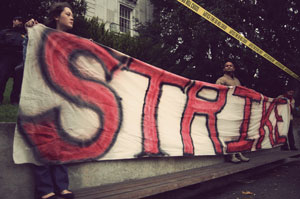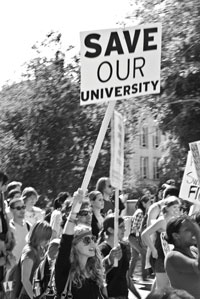
Common Ground
At 12:29 p.m. November 20, 2009, standing in the rain outside Wheeler Hall, fingers cold, iPhone soggy, Peter Glazer sent an email to the Faculty Budget Forum, a listserv at UC Berkeley:
Facility are trying to hiold the l ie at whleEr. Where istha. Administration. Please help. Contact admn. Violence mminent. In.
At 5:29 a.m. on December 11, after police had rousted sixty-six students and others in Wheeler Hall during the Open University, and herded them into a bus bound for the Santa Rita jail, a student in custody texted Greg Levine:
All I arrested.
The laconic poetry of desperation. What brought us to this place?
Is this simply a new Berkeley “mess” to be “cleaned up,” as Governor Ronald Reagan put it forty years ago in response to the Free Speech Movement? Are those of us caught up in this crisis appropriately characterized as the sandal-wearing “Berserkely” radicals Tad Friend described in the January 4 issue of The New Yorker? No, and no.

Photo by Eddie Wright
On July 21, 2009, with rumors of furloughs, emergency powers, and other actions by the UC Office of the President gaining weight, some fifty Berkeley faculty members gathered. No one was happy. The conversation was impassioned, contentious, substantive. The group found a name: SAVE the University. The name bespoke a crisis: the State of California’s withdrawal of hundreds of millions of dollars of funding for UC and public higher education generally. The name states the action: protecting accessible and affordable education and research of the highest caliber at Berkeley and system wide. And by now, SAVE has made a name for itself, for better or worse, depending upon whom you ask.
Since last July, we have served as Co-Chairs of SAVE’s Coordinating Council—SAVE’s ad hoc administrative body—alongside roughly ten colleagues. The Coordinating Council’s efforts have focused on education and mobilization. SAVE organized a teach-in on the eve of the first UC system-wide strike against budget cuts and fee hikes, and staged a reading of Clifford Odet’s play Waiting for Lefty on the eve of the second. We co-organized the “Week of Higher Education” in October, working with the Mario Savio Board, the Solidarity Alliance, and other groups. Our members have spoken publicly at meetings of the Regents and the Gould Commission and written press releases, petitions, letters to The New York Times, and Op-Eds. We have sent innumerable email messages to faculty and students across UC and CSU, to the press, and to national figures in education. We have held meetings with students, union members, legislators, the Chancellor, other members of the Berkeley Administration, and faculty at other UC campuses.
This list nonetheless fails to capture the conflicts and contradictions of these past months. Seeking to bridge to multiple campus groups, SAVE has run up hard against positions of authority and tested the boundaries of advocacy and resistance. For some, we have erred too often on the side of caution; for others, our actions have been too aggressive. SAVE faculty who advocated non-violence, and stood at the barricades between riot police and students at Wheeler Hall, were condemned by students who chose the principle of “occupy everything,” and may have seen violence as productive. The end of faculty salary reductions, we have been told on many occasions, will be achieved on the backs of students paying higher fees. Many faculty are distrusted by workers, whose unions have fought with the Administration for years. The ideologue, Svengali, mediator, spectator, policy analysis, agitator, apologist, and the apathetic have all been here on campus.
For many of SAVE’s several hundred members, UC President Mark Yudof and the Regents’ often inept, if not hubristic comments—among them the infamous “cemetery” analogy (The New York Times, Sept. 27, 2009)—belie the deep structural and conceptual changes they are imposing on public higher education in California. Despite the Administration's claims, the problem lies not merely with Sacramento but also with “in-house” decisions, and abdications, by the Regents: not making a forceful case for public education to the people of California in a timely fashion; embarking on potentially catastrophic financial maneuvers that remain only partly reported; papering-over the withdrawal of state funds with selectively targeted private money. The “P-word” (privatization)—the abrogation of the Master Plan for Education through the conversion of public education into a commodity—has become a flashpoint, for faculty and others. The arguable dismantling of faculty shared governance has also engendered widespread alarm.
What is at stake for many members of SAVE is clear: that affordable university education for all the people of California, and beyond, is a right as profound as any constitutionally protected freedom. Many share an acute consciousness of history. This is a struggle to define what “Our University” means forty years after the Free Speech Movement, in a world impoverished by Prop 13, Prop 208, and Prop 8, facing challenges for which education is perhaps the only solution.
The contours of this crisis have been clear to many since the early fall, but we could not have imagined the violence that would subsequently erupt. Riot police have come to our campus and students have been beaten; the Chancellor’s residence has been attacked. There has been confrontation and chaos. “The menacing shapes of our fever,” Auden wrote, “are precise and alive.”

Photo by Abhi Yerra
We are learning in ways we may never have imagined. We’ve learned that the right to education is not a high-minded concept. It is a struggle to be undertaken here and now, as our students are hit with fee increases so large that some will be unable to finish their education. Fee hikes and increased out-ofstate enrollments will likely have devastating impact on campus diversity, both ethnic and socio-economic; the long struggle of students of color is now grim indeed.
The Administration is committed to getting Berkeley through this crisis, but we have discovered that key members of the Administration have been invisible at moments when their leadership presence might have eased tensions. We have been forced to question administrative decisions that seemed to inflame rather than calm and unite. We know that information sharing by cell phone, text message, Twitter, Facebook, and YouTube has transformed protest. Technology has also created a new ivory tower from which it is possible to mine each policy issue, criticize each opinion to an atomistic level while avoiding face-to-face discourse. We have learned that civil discourse is just as fragile as it is essential; empathy may be the most precious option we have. We have learned, over and over, countless reasons to be proud of our students.
This spring appears daunting. We must affirm the meaning of community on campus and the unyielding power and necessity of non-violence, without sacrificing the right of protest. We must mobilize for March Forth! (March 4) on Sacramento and build broad support for the California Democracy Act, AB656, reform of Prop 13, and other productive proposals. Toward these goals, SAVE circulated a teaching kit for students and families to lobby state legislators. Both its wording and timing were promptly questioned by some faculty—how could we distribute this in the immediate wake of the attack on the Chancellor’s Residence? Not an inappropriate question, certainly, though if the teaching kits have a real impact in Sacramento, is unfortunate timing a justifiable risk?
There is so much to be done. In this struggle, there are no sidelines. We will not achieve seamless solidarity, but we must find our common ground here, and strengthen UC Berkeley as an unmistakable and unalienable part of the shared public good of California. “Our University” is in our hands.
Peter Glazer is Associate Professor in the Department of Theater, Dance & Performance Studies.
Gregory Levine is Associate Professor in the Department of History of Art.
This article can be found in the February/March 2010 newsletter.